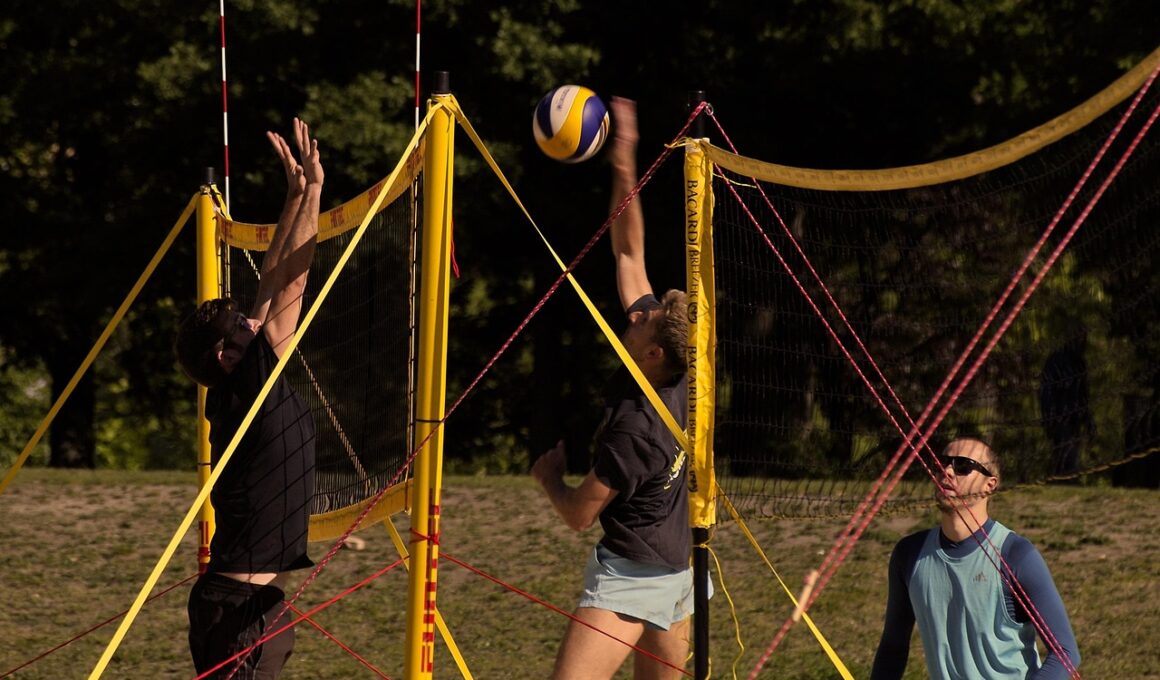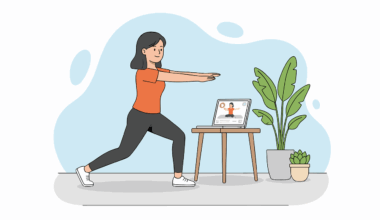Incorporating Plyometrics into Youth Volleyball Training
Plyometrics is an essential component of youth volleyball training that enhances athletic performance. These exercises focus on explosive movements, crucial for athletes who need to jump higher and move more quickly on the court. Implementing plyometric drills into training programs can improve an athlete’s overall agility, strength, and coordination, which are vital attributes for volleyball players. Understanding the importance of plyometric training allows coaches to devise effective workout plans tailored specifically to the needs of young athletes. By enhancing their ability to generate power, players will find themselves better equipped to execute jumps, spikes, and serves with improved precision. Furthermore, plyometric exercises like box jumps, bounding, and depth jumps can help in developing muscle strength in a safe, controlled environment. To maximize benefits, it’s essential for coaches to design variety in the training routines, allowing athletes to engage different muscle groups. Moreover, maintaining the correct form during plyometric workouts is critical in preventing injuries. Thus, it is essential for trainers to oversee the sessions closely. Providing feedback during drills helps young athletes understand their strengths and areas for improvement, fostering their long-term development.
Youth athletes can significantly benefit from the implementation of plyometric training in their volleyball conditioning routines. The primary objective of such exercises is to improve the muscle’s elasticity, enabling quick transitions from eccentric to concentric movements. This allows players to change direction rapidly while maintaining speed and efficiency. Additionally, plyometrics contribute to increased joint stability, ultimately safeguarding the athlete against common volleyball injuries. Coaches should ensure that their young athletes engage in a comprehensive warm-up prior to the initiation of plyometric exercises. A proper warm-up prepares the body by elevating heart rates and increasing blood flow to the muscles, thus reducing the risk of strains and sprains. It is also crucial to introduce plyometric training in a progressive manner; starting with basic drills ensures that athletes have the necessary foundational strength before progressing to advanced exercises. Examples of fundamental drills include jump squats and lateral hops which can be easily scaled as the athletes grow stronger. Furthermore, incorporating recovery times between sets will help athletes to regain their energy, ensuring optimal performance during training sessions.
Benefits of Plyometric Training for Young Volleyball Players
One of the most persuasive arguments for including plyometrics in youth volleyball training is the improved vertical leap athletes can achieve. Volleyball requires significant jumping prowess for both offensive and defensive plays, and being able to jump higher gives players a considerable advantage. Plyometric exercises, such as tuck jumps and single-leg hops, directly target the muscle groups involved in jumping, leading to noticeable enhancements in vertical jump ability. Moreover, plyometrics enhance muscular power, defined as the ability to exert maximum force in minimal time, crucial for effective plays. Improved power not only impacts jumping but also can lead to faster serves and spikes, increasing the chances of scoring. Delving into plyometric training can boost an athlete’s confidence, as they see tangible progress resulting from their hard work. As skills improve, players are likely to experience increased motivation, fostering a positive training atmosphere. Coaches are encouraged to celebrate these improvements, emphasizing the correlation between effort and success. Regular feedback during training nurtures a supportive environment, encouraging young athletes to strive towards their goals.
Additionally, incorporating plyometric exercises into training regimens promotes a sense of camaraderie among young players. Group activities or challenges can trigger friendly competition, enhancing teamwork and bonding on and off the court. Volleyball is inherently a team sport, and fostering relationships within the team can translate to better on-court performance. Creating a fun atmosphere around plyometric training sessions ensures that young athletes remain engaged and motivated. This approach not only develops physical abilities but also instills valuable life skills such as discipline and resilience. Furthermore, the repetitive nature of plyometric training solidifies muscle memory, leading to more accurate movements during actual gameplay. This synergy between practice and performance is vital for athlete development. Importantly, incorporating plyometrics helps players recognize their own athletic capabilities. As their strength and agility increase, athletes gain self-awareness, which is essential for personal growth. Coaches should facilitate an environment where young players feel comfortable pushing their limits and setting personal goals. Ultimately, the integration of plyometrics in youth volleyball training cultivates both physical prowess and mental fortitude.
Key Plyometric Exercises for Youth Volleyball Training
Identifying the most effective plyometric exercises is crucial for enhancing youth volleyball training programs. Some foundational exercises include squat jumps, lateral bounds, and depth jumps, each systematically targeting the primary muscle groups used in volleyball. Squat jumps build strength in the legs while landing helps with joint stability. Lateral bounds mimic the side-to-side movement frequently seen in volleyball, enhancing agility. Depth jumps, featuring a controlled landing from a height, develop explosive power, essential for successful spikes. Coaches should introduce these exercises gradually, ensuring that athletes are comfortable with the movements before advancing. Additionally, proper technique must be emphasized to prevent injuries during training. Athletes should also be instructed on the significance of proper landing mechanics. For instance, when landing from a jump, players must aim to land softly on the balls of their feet while keeping a slight bend in their knees to absorb impact. Incorporating a mix of drills keeps training sessions fresh and exciting. Completing warm-up, plyometric, and cooldown routines should ideally span 60 to 90 minutes, providing young players ample opportunity for skill advancement.
Monitoring the progress of youth athletes who engage in plyometric training is essential to evaluate its effectiveness. Coaches can track improvements in various areas such as vertical jump height, speed, and overall performance during scrimmages and games. Utilizing tools like vertical jump testing equipment can offer quantifiable data, allowing athletes to see their gains clearly. Moreover, regular assessments provide insight into which exercises yield the best results, enabling tailored training programs for individual athletes. Along with physical evaluations, incorporating qualitative assessments can gauge an athlete’s confidence and skill level during competitions. This dual approach ensures that the training remains comprehensive and focused on the athlete’s overall development. Additionally, collaboration with strength and conditioning experts can enhance coaching strategies, incorporating sport-specific exercises alongside plyometrics. Furthermore, keeping an open line of communication with athletes allows coaches to adjust training and set realistic goals. Creating individual training targets based on an athlete’s development can enhance motivation and self-efficacy. Tracking and evaluating athlete progress through structured methods can lead to improvements in performance and set the stage for long-term success in volleyball.
Conclusion: Embracing Plyometrics in Youth Volleyball Training
Incorporating plyometric exercises in youth volleyball training programs is a strategic approach to enhance athletic performance among young players. The advantages of plyometrics are numerous, including improved jump height, explosive power, and muscle stability. Additionally, these exercises cultivate a sense of teamwork and a positive training atmosphere, which is vital for personal growth and development. It’s essential for coaches to prioritize athlete safety and employ appropriate progression in training routines. Prioritizing correct form and technique will minimize injury risks, helping athletes to enjoy their training. As youth volleyball players enhance their physical abilities through plyometrics, they are likely to experience a boost in confidence, further solidifying their passion for the sport. Continuous evaluation and adaptations to training programs will ensure athletes remain challenged and motivated. Coaches and trainers should actively communicate with players, acknowledging their efforts and encouraging them to set ambitious personal goals. Ultimately, embracing plyometric training within youth volleyball programs provides a solid foundation for not just better athletes, but well-rounded individuals who are prepared for challenges both on and off the court.


